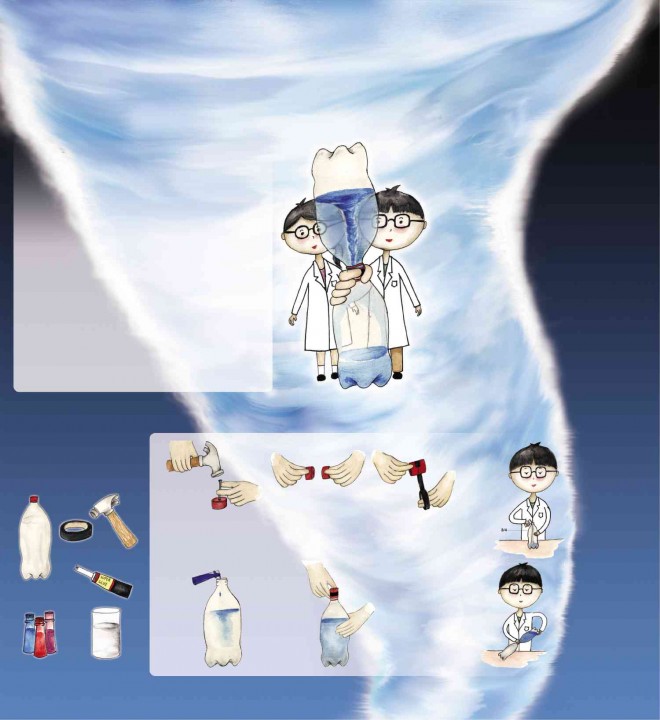Tornado in a bottle
 What is the difference between a tornado and a typhoon?
What is the difference between a tornado and a typhoon?
A typhoon is created in low-altitude belts over the ocean, like the Pacific, generally near the equator. The Philippines is visited by an average of 20 typhoons every year.
A tornado, on the other hand, generally forms several thousand feet above the Earth’s surface, usually during warm, humid weather.
There are also differences in size, wind velocity or speed, rate of travel or movement and duration.
A typhoon has winds with a velocity ranging from 60 to 250 kilometers per hour and moves between 10 and 30 kph or more. It can have a diameter of up to 600 kilometers and can exist from days to a week.
A tornado reaches rotating speeds of up to 480 kph. It travels between 40 and 70 kph and generally lasts just a few minutes (although it can exist for hours).
This experiment requires the use of a hammer, a nail and super glue. Adult supervision is required.
Did you know?
Most tornadoes revolve counterclockwise in the Northern Hemisphere (the Earth’s half that is north of the equator) and clockwise in the Southern Hemisphere (south of the equator). This also happens when you drain a sink or flush the toilet; the water spins counterclockwise in the United States and clockwise in Australia.
THE EXPERIMENT
Let us make a tornado in a bottle! In this fun Science experiment, you will make a mini tornado that is a lot safer than the one you hear about on weather reports.
What you need
2 clear 1.5-liter soda bottles with caps
3-inch nail and hammer
Electrical tape
Super glue
Water
Food color (optional)
Step 1: Ask the teacher or an adult to use the hammer and the 3-inch nail to puncture a hole in each of the two bottle caps. Make sure that the hole is at least as big as the diameter of your pencil. Do not do this on your own.
Step 2: After making the holes, your teacher has to use super glue to securely connect the flat sides of the caps. Make sure no glue gets in the holes. To make sure the caps are held together even more securely, wrap electrical tape around the connected caps.
Step 3: Clean the soda bottles and remove any labels. Fill one bottle with water up to the three-fourth level.
Step 4: Add a few drops of food color into the water in the bottle for effect.
Step 5: Attach one of the connected bottle caps to the bottle with water. Once in place, put the empty bottle on top and screw it into the other bottle cap.
Step 6: Turn the bottles upside down so the bottle with water is on top and the empty one is at the bottom. Holding on to the connected caps, swirl the bottles in a circular motion for a few seconds so the water will pour into the empty bottle. Stop to see if a mini tornado is forming in the top bottle as the water drains into the bottom bottle. Invert the bottles so the empty one is at the bottom again and place on a table. Rotate the top bottle a few times and again you’ll see the water form a spiraling funnel as it rushes into the bottom bottle.
The Science
Swirling the filled bottle in a circular motion creates a vortex or a whirling mass of water that looks like a mini tornado. It allows air to get easily into the bottle and the water to pour out faster. The water rapidly spins around the center of the vortex because of centripetal force, which is an inward force directing fluid (such as water) toward the center of its circular path.
Takeaway learning
After experiencing Typhoon “Ruby” last week and Supertyphoon “Yolanda” last year, it is important for you to be prepared against natural calamities.
If you live in low-lying areas, follow the advice of authorities to go to evacuation areas for your safety.
Prepare an emergency kit consisting of a transistor radio, flashlight, first aid kit, water and food.
Regularly monitor the news for updates on the typhoon or other forms of natural calamities. It pays to be prepared!
Using the newspaper
For the past few years, big typhoons have been hitting parts of the Philippines nearing or during the Christmas season. Many people have lost family and homes, making it hard for them to be happy during the holidays.
Read the weather forecast story in the Inquirer. Now imagine you are a weather reporter. Write a weather forecast for Dec. 25. Will it be cloudy with a chance of rain? Should people bring umbrellas? Will there be heavy rains? Should people prepare for evacuation instead of a party? Will it be sunny? Will there be nice weather that will allow children to go out and visit their ninong and ninang? Or will it snow? Go ahead, imagine away! You can include drawings in your Christmas Day weather forecast.
Last of the series
The joy of discovery. The fun of learning.
These are the experiences that Bayer hopes it has passed on to young people in keeping with its mission, “Bayer: Science for a Better Life,” and its enthusiasm for research in this series.
We hope that by doing together simple, educational and fun experiments, elementary school students have been encouraged to learn Science by doing Science.
This last experiment, like the others in the Bayer Smiling Kiddie Einsteins series, also offers teachers, parents and students hands-on and inquiry-based experiences that involve observing, experimenting, hypothesizing, analyzing and testing.
Through this series of experiments related to health, agriculture- nutrition and hi-tech materials, Bayer and Inquirer in Education have aimed to deepen the interest of elementary school pupils in Science.















